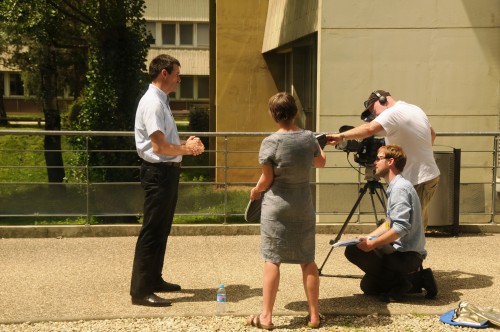By James Dacey

This photo looks a little bit like we were filming the moment that I got down on my knee and popped the big question to Andrew Harrison, the Director General of the Institut Laue-Langevin (ILL). While that would certainly make for an intriguing story worthy of a blog entry, the truth is that earlier this week we were interviewing Harrison for a short film about his international research facility. In case you are still wondering, the reason I am kneeling is so that we could frame our shot to include the dome that houses the ILL’s nuclear reactor, where neutrons are generated.
The film is part of a series of short films we have been recording this week in Grenoble, France, about some of the city’s scientific research centres. For those of you unfamiliar with the ILL, it provides a reactor-based source of neutrons that is used by a wide variety of scientists to study the properties of matter. For instance, we interviewed one physicist, Andrew Wildes, who uses the neutrons to measure the structures and dynamics involved in magnetism. The beauty of neutrons is that they have no electric charge but they do have a magnetic moment that interacts with magnetic induction in samples.
We actually spent the majority of our time filming at the European Synchrotron Radiation Facility (ESRF). This centre, located on the same campus as the ILL, provides a source of X-rays for peering inside materials. Our films will look at the basic principles of synchrotrons – what they are, how they produce X-rays and the type of science that can benefit from these giant imaging tools. One of our films will look at a pioneering microtomography technique developed at the ESRF that is enabling palaeontologists to examine fossils in unprecedented detail.
We also wanted to look at the user experience of working at the ESRF. The competition for time on the beamline is tough and users talked about the need to make every second count when visiting the lab. So, another of our films will look at people’s personal experiences of travelling to Grenoble and putting in long hours on the beamline, never certain of whether their experiments will return the data they need to publish.
Now we’ve got all the footage, the real graft will start in earnest as we begin the edit. The films will be appearing within the next few months on physicsworld.com.
The Grenoble-based ILL (Institut Laue-Langevin) which with its high-neutron flux reactor and a wide range of measuring instruments has been working for about 40 years and is still the best lab in the world. The ESRF that was supposed to be installed somewhere else was brought to Grenoble due to the presence of ILL and both the labs have been working in tandem succesfully.
Trackback: Blog - physicsworld.com